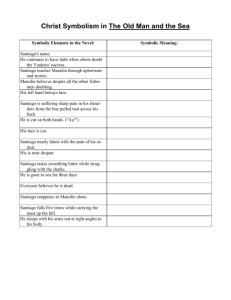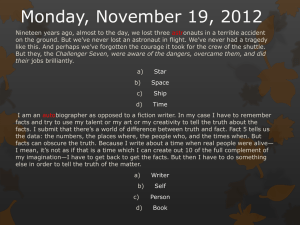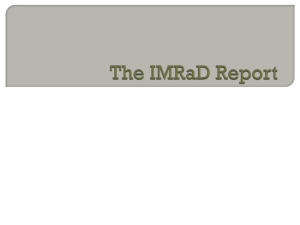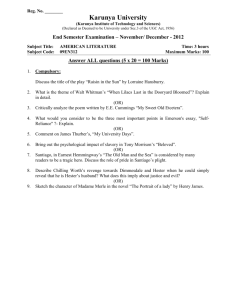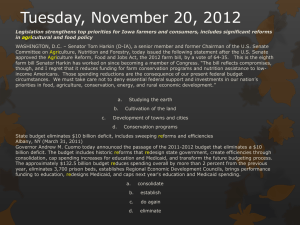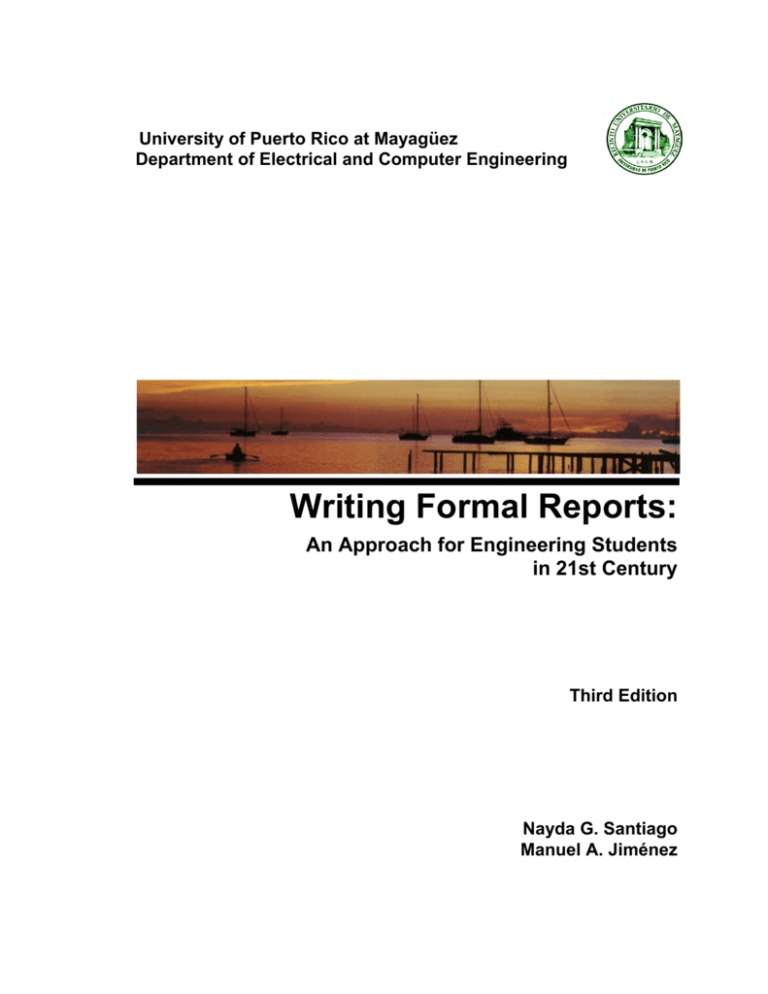
University of Puerto Rico at Mayagüez
Department of Electrical and Computer Engineering
Writing Formal Reports:
An Approach for Engineering Students
in 21st Century
Third Edition
Nayda G. Santiago
Manuel A. Jiménez
Writing Formal Reports
Third Edition
Copyright 1992, 1995, 2002 by Nayda G. Santiago and Manuel A. Jiménez
Electrical and Computer Engineering Department
University of Puerto Rico at Mayagüez
This is a copy of a document under development.
All rights reserved. No part of this publication may be reproduced, stored in a retrieval system, or
transmitted, in any form or by any means, electronic, mechanical, photocopying, recording, or otherwise
without the previous written permission of the authors and without this copyright notice.
Printing History:
Writing Formal Reports
Copyright 1992, by Nayda G. Santiago
Electrical and Computer Engineering Department
University of Puerto Rico at Mayagüez
Writing Formal Reports: A Laboratory Approach, Second Edition
Copyright 1992, 1995, by Manuel A. Jiménez and Nayda G. Santiago
Department of Electrical Engineering
Michigan State University
Writing Formal Reports: An Approach for Engineering Students in the 21st Century, Third Edition
Copyright 1992, 1995, 2002 by Nayda G. Santiago and Manuel A. Jiménez
Electrical and Computer Engineering Department
University of Puerto Rico at Mayagüez
Writing Formal Reports (3rd Edition)
Contents
PREAMBLE....................................................................................................................II
CREDITS.........................................................................................................................II
1
2
3
INTRODUCTION TO FORMAL REPORTS ......................................................1
1.1
REPORT COMPONENTS ........................................................................................1
1.2
ADDITIONAL PARTS ............................................................................................2
STRUCTURE OF REPORT COMPONENTS .....................................................2
2.1
THE TITLE PAGE .................................................................................................2
2.2
THE ABSTRACT ...................................................................................................4
2.2.1
Types of Abstracts ......................................................................................4
2.2.2
Dos and Don’ts About Abstracts ...............................................................5
2.3
THE TABLE OF CONTENTS...................................................................................6
2.4
OTHER LISTS OF CONTENTS ................................................................................7
2.5
THE INTRODUCTION ............................................................................................7
2.6
THEORETICAL BACKGROUND..............................................................................8
2.7
DISCUSSION ........................................................................................................8
2.7.1
About Figures and Tables..........................................................................9
2.7.2
Reporting Comparisons ...........................................................................10
2.8
THE CONCLUSION .............................................................................................10
2.9
THE FUTURE WORK ..........................................................................................11
2.10
THE REFERENCES..............................................................................................11
2.11
THE APPENDIX ..................................................................................................12
SUGGESTIONS FOR REPORT WRITING ......................................................13
N. Santiago & M. Jiménez (Feb. 2002)
i
Writing Formal Reports (3rd Edition)
Preamble
This document attempts to bring to young audiences the authors’ experiences in
writing and evaluating formal, technical reports. Rather than establishing a set of hard
rules for technical writing, our purpose is to provide to early writers in the academic
environment, especially in engineering fields, a handful of easy to follow ideas that might
result useful when it comes to formally presenting the results of their work.
In this new edition, we have included suggestions and ideas on how to describe
design constraints considerations, teamwork efforts, and multidisciplinary issues in a
practical way. Also included are highlights for dealing with web-based material and the
usage of contemporary editing tools.
Nayda G. Santiago
Manuel A. Jiménez
Credits
Cover design and picture by M. Jiménez
Selected topics in this document were adapted from the following sources:
1. Blicq, Ron S., Writing Reports to Get Results: Guideline for the Computer Age,
IEEE Press, 1987.
2. Lloréns, Baldomero, Class notes ELEG 4165, Univ. of Puerto Rico at Mayagüez,
1991.
3. Michaelson, Herbert B., How to Write & Publish Engineering Papers and Reports,
3rd Edition, Oryx Press, 1990.
4. Pringle, Alan S., O’Keefe Sarah S., Burns, Bill, Technical Writing 101 : A RealWorld Guide to Planning and Writing Technical Documentation, Scriptorium
Press, 2000
N. Santiago & M. Jiménez (Feb. 2002)
ii
Writing Formal Reports (3rd Edition)
1 Introduction to Formal Reports
A formal report must be written keeping in mind that it is an important document. Its
information must be appropriately placed, distributed, and spaced with the purpose of
creating an impression of confidence from beginning to end.
1.1 Report Components
The six main components of a formal report include:
•
•
•
•
•
•
Abstract
Introduction
Discussion
Conclusion
Future Work
Appendix
The following diagram summarizes the contents of each part of the report:
Main Message
Abstract
A summary of the purpose, main results and
findings
Background
Introduction
Previous knowledge of the situation, purpose
and scope of the project
Theory
Short development of the technical content of
the report
Facts and Events
Discussion
Detailed description of the project, including
approach, presentation and analysis of results
Results
Conclusion
Summary of main results and findings
Future Work
What action must be taken, if any
Support
Appendix
N. Santiago & M. Jiménez (Feb. 2002)
Detailed data: Evidence to support the
discussion
1
Writing Formal Reports (3rd Edition)
1.2 Additional Parts
Additional parts provide completeness to the report. The list below outlines the most
commonly included parts in a report. Essential parts for completeness are in boldface,
and the numbers on the left suggest numbered sections.
1.
2.
3.
4.
5.
6.
Front Cover
Title Page
Abstract
Table of Contents
List of Figures (if necessary)
List of Tables (if necessary)
Introduction
Theory
Discussion
Conclusion
Future Work (when necessary)
References
Appendix
Back Cover
2 Structure of Report Components
Descriptions of the different parts of a report are included in more detail in the
following sections.
2.1 The Title Page
This is the first page that must appear in any technical document. The title page
contains four main elements:
1. Complete title of the report.
extensive.
It must be informative without being too
2. Name of the organization and, in some cases, name of the person for whom
the report has been prepared.
3. The name of the organization and persons that prepared the project.
4. The date when the report was written, and, sometimes, a report number.
A title page must have aesthetics yet be simple and dignified. Every line is suggested
to be centered. Remember to leave a larger margin at the left of the page. This side of
N. Santiago & M. Jiménez (Feb. 2002)
2
Writing Formal Reports (3rd Edition)
the page is usually covered by a binder or punched for multiple-ring binders. Figure 1
shows a sample layout for the margins in a typical report page.
margin: 1 in.
Typing Area
margin: 1.5 in.
Figure 1: Layout of a typical report page.
An illustrative example of a cover page is provided in Figure 2.
organization of the provided information and its contents.
Notice the
University of Puerto Rico
Mayagüez Campus
Mayagüez, Puerto Rico
Department of Electrical and Computer Engineering
Design of an Automatic Control System
by
Pedro Silva
For: Professor B. Lloréns
Course: INEL 4165, Section 101
Date: March 19, 2002.
Figure 2: Illustrative cover page
N. Santiago & M. Jiménez (Feb. 2002)
3
Writing Formal Reports (3rd Edition)
2.2 The Abstract
For an engineer, the abstract of a report serves two basic purposes: (1) For the reader,
the abstract reveals the main findings and the importance of the report; (2) For the
author, preparing the abstract requires briefly stating the central idea in unmistakable
terms.
In the formal report, the abstract is placed immediately after the title page but before
the table of contents. The abstract always has a page for itself and it is vertically centered
on the page. The abstract page begins with the title "Abstract" and is usually written in
passive voice.
Despite its length, the abstract is the most important part of a report since it is the first
information that the reader receives. It should motivate the reader to continue reading
your report. If the abstract does not do that, it has failed in its purpose. In addition, the
abstract should let the reader know whether the information that he or she is looking for
is contained in the report or not. If the abstract fails to enlighten the reader about the
contents of the report, it will most likely not be read.
2.2.1 Types of Abstracts
There are three main types of abstracts:
1. Indicative or Descriptive: This type of abstract establishes the main subject of
the document. To achieve this, it uses qualitative descriptions. A simple
vocabulary is recommended so that the contents of the report can be easily
understood.
2. 2. Informative: An informative abstract points out the discoveries and
results in a short and quantitative way. It is a condensed version of the
engineering work without discussion or interpretation. Sentences are made
with technical terms, intended to be understood by experts in the subject.
3. 3. Informative-Indicative: This last type of abstract combines the two
previous styles. It provides both specific information about the findings and
results, and general information and explanations about the rest of the
document.
The kind of abstract to write depends on the subject of the project and the audience
for whom of the report was written.
An Informative, or Informative-Indicative abstract, typically has the following parts:
1. A main sentence where the problem is established.
2. An explanation of the approach taken in solving the problem. The approach
could be an analytical method, a design technique, a trial diagram, etc. Note
N. Santiago & M. Jiménez (Feb. 2002)
4
Writing Formal Reports (3rd Edition)
that although you might reference a diagram, an abstract should never contain
such.
3. The main result of the project. This includes theoretical and experimental
results such as: the new improved characteristics of the system; the
recommended course of action to be taken; etc.
2.2.2 Dos and Don’ts About Abstracts
The following guidelines provide useful hints in writing effective abstracts:
1. Write the abstract after everything else in the report has been written.
2. The information to write the abstract should be obtained from:
•
The introduction (particularly from the purpose section of the
introduction)
•
The discussion (pick out the most important highlights)
•
The conclusion and future work sections of the report (the outcome or
result of the project)
3. Make the abstract as short, interesting, and informative as possible. A
reasonable length of is approximately from 5% to 10% of the report. In
general terms, an abstract of 50 to 100 words is good for a short article, while
one with around 200 words is good for an extensive article. An abstract
usually contains only one paragraph.
4. Keep in mind who will read the report in order to include the details of
interest to him or her.
5. Do not use illustrations, tables, or references. Do not use information not
contained in the report.
6. Do not include the following items in the abstract:
•
A literature revision with references to work previously done in the
area (this should be in the Introduction)
•
A discussion of the importance of the report for the company (leave
this for an Executive Summary)
•
An evaluation of a new technique or a discussion of the validity of the
results (usually part of the Conclusion)
A few abstract examples taken from "How to Write and Publish Engineering Papers
and Reports":
1. Descriptive Abstract:
"The successful design of cost-effective solar energy systems depends mainly on the
development of higher conversion efficiencies. A theory is given for the thermal
N. Santiago & M. Jiménez (Feb. 2002)
5
Writing Formal Reports (3rd Edition)
performance of a new solar collector array that combines reflected and refracted
light rays. The theory is applied to the design of a complete system for solar heating
of a building. Dynamic operating characteristics for a one-month interval are given
for the collector array and heat transfer devices, and cost efficiency is compared with
that of conventional designs."
Notice its characteristics: Short, provides the key elements of information and
serves as a miniature table of contents.
2. Informative Abstract:
"In the design of a solar energy system using arrays of multiple solar panels, the
Hottel-Whillier-Bliss (HWB) model is generally used to evaluate steady-state
efficiency. The HWB equation did not accurately predict dynamic thermal
performance for the present system, which uses a novel collector array. The
theoretical limit of energy gain for this new array is 6.5 X 106 BTU, which extends
into the nonlinear mode of the HBW equation. A modified form of the equation
was, therefore, developed for improved linearity, effective for collector efficiencies
up to 54%. An optimum ratio of 64/36 was determined for the proportion of
propylene glycol to water. Dynamic performance tests during the month of July
1980 in Phoenix, Arizona, yielded an average efficiency of 49% for a gross collector
area of 721 m2 when the array faced south at an angle of 35° from the horizontal.
Losses between collector and storage tank were 3.8 X 108 J per month. The cost
efficiency of the system was a 9% improvement over that of the SOLTHERM
system operating in Phoenix during the same month."
Notice its characteristics: Specific and quantitative. It only provides essential
data.
3. Informative-Descriptive Abstract:
"The successful design of cost-effective solar energy systems for heating buildings
depends chiefly on high-efficiency conversion of light energy into heat. A theory is
given for the thermal performance of a new solar collector array. The HottelWhillier-Bliss (HWB) model is modified for accurate prediction of the energy gain
of the new solar array. This three-stage collector, using the principle of successive
concentrations, was incorporated into the design of a complete solar energy system.
An optimum ratio was determined for the proportion of propylene glycol to water for
the fluid transferring energy from the array to storage tank. In dynamic tests during
July 1980 in Phoenix, Arizona, the average efficiency was 49% for a gross collector
area of 721 m2 when the array faced south at 35° from the horizontal. Losses
between collector and storage tank were 3.8 X 108 J per month. The cost efficiency
compared favorably with that of the SOLTHERM system operating in the same area
that month."
Notice its characteristics: It provides fewer details and emphasizes the
contribution of the author.
2.3 The Table of Contents
The table of contents is included at the beginning of the report, mainly for the
purpose of aiding the reader to find specific information. A secondary purpose of the
table of contents is to let the reader visualize how the author has organized the
information, and which topics have been covered.
N. Santiago & M. Jiménez (Feb. 2002)
6
Writing Formal Reports (3rd Edition)
Factors to take into account when writing a table of contents:
1. Each heading in the main topics of the report must be included on the table of
contents.
2. The headings of topics must appear exactly as they are written in the report.
3. The headings or titles of report subtopics may be omitted from the table if
including them makes the table too long or unclear.
4. All appendixes must be included, with the complete titles obtained from the
first page of every appendix.
5. If diagrams or illustrations are included in a separate section of the report, the
section must be included in the table of contents.
2.4 Other Lists of Contents
List of Figures (if necessary): The List of Figures, when included, is placed after the
Table of Contents. Its purpose is to aid the reader to find the location of specific figures
when their number is large in the report.
List of Tables (if necessary): In a similar way, when the number of tables in the
document is large, a list of tables aids the reader to find specific tables in the report.
When included, the list of tables is placed after the List of Figures.
2.5 The Introduction
The Introduction prepares the reader for the details that follow in the discussion. It
presents the circumstances that led up to the project, the reasons for the project's
existence, and why the report was written.
The Introduction has three main components:
1. The Background: Describes the events leading up to the existing situation,
what projects (if any) have been made before (including different approaches),
and why the project or study is necessary.
2. The Purpose: Defines what must be obtained out from the project or study,
who authorized it, and the focus of the project.
3. The Scope: Points out the constraints imposed on the project by the persons
who authorized it or did it, and/or by the conditions under which the project
was completed. These constraints include economical, environmental, ethical,
and social factors that generally affect the cost, completion time, depth of the
study, and other factors that might or might not be included.
Other parts typically included in the introduction are:
•
The Problem Statement: Describes the problem that has to be solved in such
way that the reader appears as the person who is solving the problem. This
N. Santiago & M. Jiménez (Feb. 2002)
7
Writing Formal Reports (3rd Edition)
section may appear as an individual section of the report just before the
Introduction, or as part of the introduction itself.
•
The main contributions of other persons who worked previously in the
problem.
•
A Brief reference to the technical content that will be shown in the rest of the
report.
How much information and orientation does the reader require? For readers with
expertise in the area, too much information will be inappropriate. For less experienced
readers, too little information will leave them ignorant on the subject. The author has to
consider the audience when he or she is writing the introduction.
2.6 Theoretical Background
This section is where the theoretical background and the engineering design criteria
necessary for the solving problem are presented. Considerations on economical,
environmental, ethical, and/or social constraints should be addressed in this section as
well as the project logistics and timing limitations. This section should also detail the
analytical methods used to reach the results.
To support the purely technical or mathematical aspects of a project, it is not
necessary to derive all used formulas. If a derivation can be found somewhere else, a
reference to the source where it is located should be enough.
The theoretical background section is not the place to explain in detail how the results
were obtained, but rather, to present the design methods in a general way. Details are
saved for the results section of the report.
2.7 Discussion
This is the central section of your report, where de development of the project is
described in detail. A few important points about this part of a report follow:
1. The word "discussion" should not be part of the title(s) or heading(s). This
part of the report may physically have of one or several sections, as required
to fully describe how you arrived to the solution given to problem being
solved.
2. The discussion may begin immediately after the introduction, either on the
same page or on the next. In the former case, the aspects addressed by the
Theoretical Background should be distributed between introduction and the
discussion. If the discussion begins on a new page, all succeeding sections
should also begin on a new page.
The distribution and organization of the discussion section(s) is very important.
Throughout this part, the logical organization and solution approach followed in solving
N. Santiago & M. Jiménez (Feb. 2002)
8
Writing Formal Reports (3rd Edition)
the problem should be evidenced. Otherwise, the reader might not follow the author’s
logical reasoning.
Issues arising from engineering decisions with impact on the sustainability,
manufacturability, and/or safety of a solution are to be included as part of the discussion.
If the impact of these decisions is so broad that they might have implications as far
reaching as in healthy or political arenas, they should be discussed as well.
Multidisciplinary collaboration is crucial for properly addressing these issues. Therefore,
the observations and comments from experts in those areas become vital for properly
reporting such implications.
The discussion usually ends with a presentation of the results obtained from applying
the methodology or solution derived from your project, along with an analysis of their
significance. This is the place where both, positive and negative aspects of a solution are
presented and analyzed.
The guidelines in these last three paragraphs could make the difference between
approval and rejection of the conclusions given by the author.
Three factors with particularly negative effects on readers include:
1. Writing which is beyond the reader’s comprehension; that is, usage of
technical terms and jargon that may not be understood by the target audience.
2. Writing without answering doubts and without satisfying the reader's
curiosity; that is, does not anticipate their reactions to the facts, events, and
concepts you present.
3. Writing in such a way that underestimates or overestimates the reader’s
knowledge; that is, assumes they know more (or less) about the topic than
they really do.
2.7.1 About Figures and Tables
Illustrations such as drawings, plots, graphics, and photographs provide a very useful
way to help the reader visualize complex topics. However, illustrations should be chosen
and inserted in the document very carefully following these guidelines:
1. They must always serve a useful purpose.
2. They must supplement, not duplicate, what is written.
3. They must be referred to in the text.
4. They should be simple, clear, and easy to understand.
5. They must be together with a caption and, sometimes, with explaining
comments. Figure captions usually begin with the word “Figure”, followed
by a sequential figure number used for reference and the caption itself. These
captions are placed underneath the figure in the same page where the
illustration is located.
N. Santiago & M. Jiménez (Feb. 2002)
9
Writing Formal Reports (3rd Edition)
6. Ideally, they should be smaller than a whole page, so that some text appears
before or after them. Illustrations that take a whole page tend to disrupt the
continuity of the report.
7. Large, wide, horizontal illustrations occupying a full page are always
positioned so that they are read from the right. It is correct for the titles on
these illustrations to appear sideways.
Tables, in general, follow the same guidelines as illustrations, with a few exceptions:
1. Table captions begin with the word “Table” instead of Figure, and are placed
on top of the table. Tables have their own sequential numbering.
2. It is recommended to include multi-page tables as an appendix.
3. Before inserting a table of numbers in your report, consider if a plot of the
same data could be more informative. In many cases, for numeric data, a plot
could be much more informative than a table.
A final remark about web-downloaded and scanned tables and illustrations. It is
violation to Copyright law and to ethical principles to use such material without the
consent of the original author. References to the sources of such information must be
included in your report even when permission for their usage is granted.
2.7.2 Reporting Comparisons
If a comparative analysis is being made, the alternatives should always appear in
ascending or descending order considering how appropriate the alternatives are. This
means that:
•
In ascending order, the least likely choice appears first and the most likely
choice (the alternative the report writer will recommend) appears last.
•
In descending order, the best alternative is exposed first, and the least likely
alternative is placed last.
2.8 The Conclusion
The conclusion provides a summary of the discussion's results. It is important to
remember that, when writing the conclusion, there should never be surprises. That is, it
should not present new information, implying that all that appears in the conclusion must
have been discussed in previous sections. To write new ideas in the conclusion section is
one of the most common mistakes done in report writing.
The conclusion section may be placed right after the discussion section or may begin
on a new page. If the introduction section begins on a new page, the conclusion section
should appear on a new page.
General guidelines for writing a conclusion include:
1. Be as short as possible, considering the most important points of the
concluding paragraphs of the different portions of the discussion section.
N. Santiago & M. Jiménez (Feb. 2002)
10
Writing Formal Reports (3rd Edition)
2. Be presented in descending order of importance, that is, primary conclusion
first, followed by subsidiary conclusions.
3. Never promote a certain action to be taken.
4. Satisfy requirements established in the Introduction section.
5. If there are many secondary conclusions, they should be presented in
enumerated subparagraphs.
2.9 The Future Work
The future work section usually becomes necessary when reporting a project that has
not been completed yet, or if extensions on the same subject are possible, increasing the
scope of the work. In this section, the writer should clearly establish the actions to be
taken in order to complete or expand the reported work. The recommended actions
should present realistic goals. The reader should not be led to establish goals that are
impossible to meet.
This section may follow the conclusion, either immediately on the same page or on
the next page. If the conclusion begins on a new page, then the Future Work section
should appear on a new page.
2.10 The References
The references section contains a list of the documents that the author used while
conducting the project. Each reference describes the source of a specific piece of
information, and must provide enough information to allow the reader to access the
document if he or she wants to refer to it.
The references are enumerated and appear in the same sequence as the information
provided in the report.
References Example: (Paragraph taken from S. M. Sait, "Integrating UAHPL-DA
Systems with VLSI Design Tools to Support VLSI DA Courses", IEEE Transactions on
Education, vol. 35, no. 4, Nov. 1992, pp. 321-330. Additional sample entries added for
illustration.)
Integration of various hardware design tools into a complete design automation system
enables designers to gracefully interact DA systems can smooth on and speed up the flow of
digital system design from specification to manufacture. It also provides an excellent
teaching environment for DA of VLSI, a discipline that has been introduced in the
undergraduate/graduate curricula of several universities [1], [2].
The UAHPL-DA system uses a high-level computer hardware description language
(CHDL) called UAHPL to model the complex digital system to be implemented [3]. A
multistage, multiplication compiler which supports a wide spectrum of design and test
activities has been implemented for UAHPL [4]. The design described by the...
REFERENCES
N. Santiago & M. Jiménez (Feb. 2002)
11
Writing Formal Reports (3rd Edition)
[1]
M.T. O'Keefe, J.C. Lindenlaub, S.C. Bass, and T.P. Waheln, "Introducing VLSI
computer-aided design into the EE curriculum: A case study", IEEE Transactions on
Education, vol. 32, no. 3, Aug. 1989, pp. 23-39.
[2]
K.F. Smith and J. Gu, "Fast structured design of VLSI circuits", In Proceedings of
IEEE Frontiers in Education, Aug. 1991, pp. 78-47.
[3]
M. Masud and S.M. Sait, "Universal AHPL-A language for VLSI design automation",
IEEE Circuits and Devices Magazine, Sept. 1986, pp. 28-36.
[4]
VLSI Design Tools Reference Manual, Release 3.1, NW Lab. for Integ. Syst., Univ. of
Washington, Feb. 1987.
[5]
M. Masud, "Modular implementation of a digital hardware design automation system",
Ph.D. dissertation, Dept. Electric. Eng., Univ. of Arizona, 1981.
[6]
F.J. Hill and G.R. Peterson, Digital Systems: Hardware Organization and Design.
New York: John Wiley & Sons, 1973.
[7]
K. Iverson, A Programming Language. New York: Wiley, 1962.
[8]
CSE131, “Introduction to Technical Computing and Problem Solving”, URL
http://cse131.cse.msu.edu/domsite/cps/classes/131/99_spring/classhome.nsf
Note the suggested styles used to refer to entries in: journals [1], conference
proceedings [2], magazines, manuals [4], theses and dissertations [5], books [6], [7], and
web pages [8]. Although web references have become commonplace, caution should be
exercised in its usage due to the volatility of on-line material. Whenever possible, at
least until more permanent on-line sources become available, references to printed
material are preferred over those to on-line material.
2.11 The Appendix
Appendixes contain complex analyses, statistical information, manufacturer data,
tabulated data, calculations, specifications, large drawings, photographs, detailed results
on experimentation, cost comparisons and specifications, and in summary, any
information that could interrupt the continuity of the report's lecture if placed somewhere
else in the report. Sometimes, the appendixes section has more pages than the rest of the
report.
Several guidelines apply to the preparation of the appendixes section of the report:
1. Appendixes must appear always in the order in which they are referred to in
the document for the first time, and of course, there must be a reference for
every appendix.
2. Appendixes can be considered individual documents, and as such the pages of
each one could be enumerated independently beginning with "1". This
however is a seldom-used rule and in most cases, the page numbering is done
sequentially along with the main document.
3. An identifying letter is to be assigned to every appendix: "Appendix A",
"Appendix B", etc.
N. Santiago & M. Jiménez (Feb. 2002)
12
Writing Formal Reports (3rd Edition)
Because the appendix can be considered a separate document, sometimes the
appendix has its own references. References could be enumerated at the end of the
document or treated as footnotes.
3 Suggestions for Report Writing
Although there is no universal methodology for the writing of a formal report, there
are several hints that come handy when writing one. These include:
•
Begin writing when you have something to write. You will usually become ready
to begin writing when a great part of the design and required results are obtained.
•
Make an outline. To begin, make an outline of the preliminary content of the
research or project. This will help you organize your ideas and will be useful as a
preliminary table of contents.
•
Organize your references. Write a list of references before beginning to write;
this will allow you to cite them while writing the report.
•
The golden rule of order. Begin by writing the theoretical background section,
then the discussion and results and finally the introduction, the conclusions, and
the future work section. Leave the abstract for last. The introduction and the
abstract are to be written after the rest of the report has been completed because
the introduction must provide some information on how you arrived at the results,
and the abstract includes some aspects of the results and the conclusions.
•
Coordinate team effort. When reporting the work made by a team of
collaborators (multi-authored reports), always have one person, typically the
group leader, coordinating each member responsibility and overseeing the overall
report structure. Even when different people write different sections, this division
of chores must be transparent to the reader. The report must be perceived as a
single entity. It is generally recommended having only one person writing the
conclusion, introduction, and abstract of the report.
•
Number all pages. Remember to enumerate all pages and refer to every section in
the table of contents. Although this might seem an insignificant detail, not doing
so will render useless the table of contents, making difficult to navigate through
the report.
N. Santiago & M. Jiménez (Feb. 2002)
13

